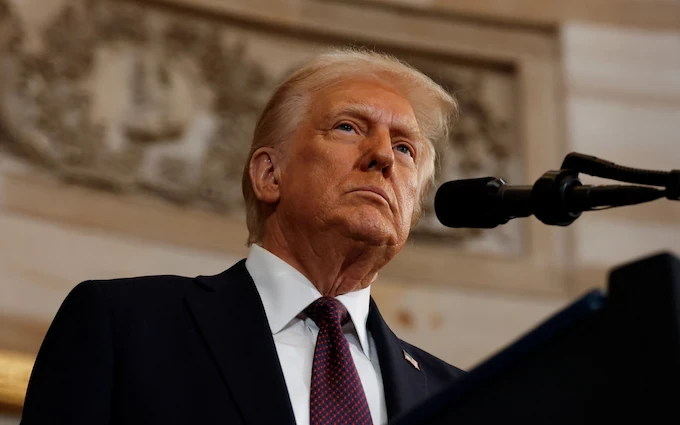
January 21, 2025 - As Donald Trump was sworn in as the 47th president of the United States, the financial markets responded with an initial burst of optimism.
On this historic day, the S&P 500 (SPX) was up 0.86% and the Nasdaq Composite up by 0.72% at the time of writing, signalling a positive market sentiment towards Trump’s return to the White House.
Here’s an in-depth look at today’s market movements, the implications of Trump’s executive orders, and what retail investors might expect in the coming days.
Market performance today
The stock market opened with a robust performance, riding the wave of Trump’s inauguration.
The S&P 500, often considered a barometer for the broader market, climbed by 0.86% at the time of writing, reflecting a broad-based rally across sectors.
This uptick suggests investor confidence, possibly driven by expectations of policy changes that could favor business growth.
Similarly, the Nasdaq, known for its tech-heavy composition, rose by 0.72%, with tech stocks gaining ground amidst expectations of less stringent regulations under the new administration.
- The brains behind Matavire’s immortalisation
- Letter from America: Is former president Donald Trump a hero or villain?
- Red Cross work remembered
- All set for inaugural job fair
Keep Reading
Notably, small and mid-cap stocks also saw gains, hitting a one-month high, buoyed by bets that they would benefit from a potential protectionist stance by Trump.
The Russell 3 000 was up 94% at the time of writing.
This performance was particularly evident in sectors like energy and space, where companies saw uplifts due to Trump’s pro-fossil fuel and space exploration policies.
Impact of Trump’s executive orders
Energy and environment: One of Trump’s first acts was to declare a “national energy emergency,” signalling a push for accelerated fossil fuel production.
This move has direct implications for the energy sector, potentially driving up stocks of oil, gas, and coal companies.
His executive order to withdraw from the Paris Climate Accord again might signal a shift towards less stringent environmental regulations, which could benefit industries freed from compliance costs but at the potential cost of long-term sustainability investments.
Immigration and labour: Trump’s moves to tighten immigration controls and end certain policies like “catch and release” at the border could have mixed effects.
On one hand, stricter immigration might lead to a tighter labor market, pushing up wages in certain sectors, which could be inflationary.
On the other hand, this could also mean a smaller workforce, impacting business growth in industries reliant on immigrant labor, like construction or agriculture.
Trade and tariffs: The market is keenly watching Trump’s approach to trade.
While he has not yet imposed the feared China-specific tariffs, his comments about potential tariffs on Canada and Mexico have introduced some uncertainty.
This has led to a nuanced market response with currency markets reacting; the Mexican peso and Canadian dollar both weakened on this news, suggesting that investors are preparing for potential economic turbulence from these policies.
Corporate regulation: Trump’s directive to review and pause all pending regulations could be a boon for big banks and businesses, easing compliance burdens.
However, this could also mean more volatility in sectors sensitive to regulatory changes like healthcare, finance, and technology.
Market volatility ahead
For retail investors, the immediate takeaway from today’s market movements and policy announcements is an expectation of heightened volatility.
Trump’s use of executive orders to enact policy changes rapidly can lead to abrupt shifts in market sentiment.
Earnings season: With major corporations like Netflix and 3M set to report earnings, the market’s reaction to these reports could be magnified by the backdrop of policy uncertainty.
Strong earnings might provide a buffer against policy-induced volatility, but weaker-than-expected results could exacerbate market swings.
Sector-specific reactions: Investors should brace for sector-specific reactions.
For instance, energy stocks might continue to see gains if more deregulatory actions are taken, while renewable energy stocks could face headwinds if the US pulls back from global climate commitments.
Currency and commodity markets: The talk of tariffs and a strong dollar policy under Trump has already begun affecting currency markets.
Investors with international holdings or those trading in commodities might see significant fluctuations as these policies take effect.
Safe-haven assets: In times of uncertainty, assets like gold or US Treasuries might see increased interest as safe havens, although the Treasury market has been somewhat volatile with recent yield movements.
Conclusion
As we navigate through Trump’s second term, today’s market performance—while positive —s hould be seen with cautious optimism.
The executive orders issued so far indicate a clear direction towards deregulation, energy sector boosts, and potentially more protectionist trade policies.
These could lead to short-term gains in certain sectors but also introduce significant volatility as markets adjust to these changes.
Retail investors are advised to stay informed, maintain a diversified portfolio, and perhaps adopt a more defensive strategy in anticipation of a roller-coaster ride in market conditions. The true impact of these policies on long-term market trends will unfold over time, but for now, volatility is the watchword.
Until next time, trade and invest wisely and may the markets be on your side!
*Isaac Jonas is a Canada-based economist and principal consultant at Streetwise Economics. He is also a retail investor, retail trader and content creator, focusing mainly on the US and Canadian capital markets. He regularly shares insights via his social media handles and YouTube channel (Streetwise Economics). His website is www.streetwiseeconomics.com and can be reachable on [email protected]. Insights shared in this article are based on current market conditions, which may be subject to change, hence this article does not amount to investment advice.










